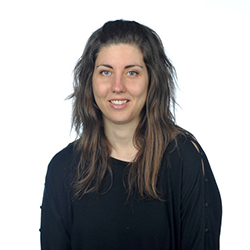Earth experienced a profound change 2.4 billion years ago. That's when oxygen, a by-product of photosynthesis, became an important component of its atmosphere.
The earliest photosynthetic organisms were blue-green algae, or cyanobacteria. Their descendants still exist today.
Cyanobacteria emerged billions of years ago, when Earth supported only anaerobic life and before life evolved mechanisms to cope with the toxic effects of reactive forms of oxygen. Abundant iron in ancient oceans exacerbated oxygen’s reactivity, making it an even stronger poison.
So how did ancient cyanobacteria cope with the effects of the toxic by-product of their own metabolism?
Starting in May, Georgia Tech’s Nadia Szeinbaum will pursue that question with a fellowship from the NASA Astrobiology Postdoctoral Program. She will assemble microbial communities to test the hypothesis that cyanobacteria survived rising oxygen with help from other bacteria.
“Many modern cyanobacteria have limited ability to counter the toxic effects of the oxygen they themselves produce,” Szeinbaum says. Instead, they rely on other bacteria that produce catalase, an enzyme that detoxifies oxygen.
“Could it be that this cooperative relationship was what allowed cyanobacteria to succeed and adapt to oxygen billions of years ago?” she asks.
To address the question, Szeinbaum will create a community of model cyanobacteria and catalase-producing bacteria under conditions of ancient Earth – with just a bit of oxygen and lots of iron. In this environment, Szeinbaum says, oxygen is highly toxic to cyanobacteria, but not to catalase-producing bacteria.
In modern ecosystems, the model organisms typically live apart, but evidence suggests that their ancestors may have helped each other adapt as oxygen rose. Szeinbaum hopes her experiments will yield insights about what happened billions of years ago.
Szeinbaum is a postdoctoral researcher in the labs of Jennifer Glass, Christopher Reinhard, and Yuanzhi Tang, assistant professors in the School of Earth and Atmospheric Sciences. Born, raised, and educated in Argentina, Szeinbaum came to Georgia Tech to study wastewater treatment.
After receiving a master’s degree in environmental engineering in 2009, she switched her focus to anaerobic physiology and microbial genetics. She joined the lab of School of Biological Sciences Professor Thomas DiChristina and earned a Ph.D. 2014.
Szeinbaum is among many early-career scientists addressing the fundamental questions driving the burgeoning field of astrobiology at Georgia Tech: How did life start? Where could life exist outside Earth? Where is life going on Earth and beyond? How would we recognize life outside of Earth?
The conditions of early Earth could be similar to current conditions in potentially habitable bodies in the universe, Szeinbaum says. “Understanding what forms of life may have existed in the past can help us understand whether life exists somewhere else.”
For More Information Contact
A. Maureen Rouhi, Ph.D.
Director of Communications
College of Sciences



